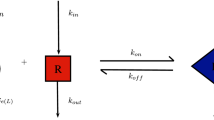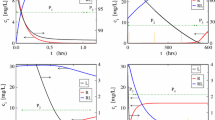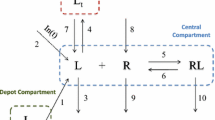Abstract
In this paper we present a mathematical analysis of a pharmacological ODE model for target mediated drug disposition (TMDD). It is known that solutions of this model undergo four qualitatively different phases. In this paper we provide a mathematical identification of these separate phases by viewing the TMDD model as a singular perturbed system. Our analysis is based on geometric singular perturbation theory and we believe that this approach systemizes—and sheds further light on—the scalings arguments used by previous authors. In particular, we present a novel description of the third phase through a distinguished solution of a nonlinear differential equation. We also describe the solution curve for large values of initial drug doses and recover, en route, a result by Aston et al. (J Math Biol 68(6):1453–1478, 2014) on rebounding using our alternative perturbation approach. Finally, from our main result we derive a new method for estimating the parameters of the system in the event that detailed data is available. Ideally our approach to the TMDD model should stimulate further research into applications of these methods to more complicated models in pharmacology.










Similar content being viewed by others
Notes
Notice also that the position of the weak eigenspace in this case implies that \(\dot{y}<0\) along \(y=1\) for all z, \(\epsilon >0\) sufficiently small. In fact, inserting \(y=1\) into (31) gives this directly: \(\dot{y}=-\epsilon z(\delta -\alpha +\mathcal {O}(\epsilon ))\).
References
Aston PJ, Derks G, Raji A, Agoram BM, van der Graaf PH (2011) Mathematical analysis of the pharmacokinetic-pharmacodynamic (pkpd) behaviour of monoclonal antibodies: Predicting in vivo potency. J Theor Biol 281(1):113–121
Aston PJ, Derks G, Agoram BM, van der Graaf PH (2014) A mathematical analysis of rebound in a target-mediated drug disposition model: I. Without feedback. J Math Biol 68(6):1453–1478
Bossolini E, Brøns M, Kristiansen KU (2017) Singular limit analysis of a model for earthquake faulting. Nonlinearity 30(7):2805–2834
Dua P, Hawkins E, Van Der Graaf PH (2016) A tutorial on target-mediated drug disposition (tmdd) models
Fenichel N (1971) Persistence and smoothness of invariant manifolds for flows. Indiana Univ Math J 21:193–226
Goeke A, Walcher S, Zerz E (2015) Determining “small parameters” for quasi-steady state. J Diff Equ 259(3):1149–1180
Jones CKRT (1995) Geometric singular perturbation theory, lecture notes in mathematics, dynamical systems (montecatini terme). Springer, Berlin
Kaper T (1999) An introduction to geometric methods and dynamical systems theory for singular perturbation problems. Proc Symp Appl Math 56:85
Kosiuk I (2012) Relaxation oscillations in slow-fast systems beyond the standard form. PhD thesis, University of Leipzig
Kosiuk I, Szmolyan P (2009) Geometric singular perturbation analysis of an autocatalator model. Discrete Contin Dyn Syst Seri S 2(4):783–806
Kosiuk I, Szmolyan P (2011) Scaling in singular perturbation problems: blowing up a relaxation oscillator. Siam J Appl Dyn Syst 10(4):1307–1343
Kosiuk I, Szmolyan P (2015) Geometric analysis of the Goldbeter minimal model for the embryonic cell cycle. J Math Biol 72:1337–1368
Krupa M, Szmolyan P (2001a) Extending geometric singular perturbation theory to nonhyperbolic points-fold and canard points in two dimensions. SIAM J Math Anal 33(2):286–314
Krupa M, Szmolyan P (2001b) Extending slow manifolds near transcritical and pitchfork singularities. Nonlinearity 14(6):1473
Kuehn C (2015) Multiple time scale dynamics. Springer, Berlin
Levy G (1994) Pharmacologic target-mediated drug disposition. Clin Pharmacol Ther 56(3):248–252
Mager DE, Jusko WJ (2001) General pharmacokinetic model for drugs exhibiting target-mediated drug disposition. J Pharmacokinet Pharmacodyn 28(6):507–532
Meiss JD (2007) Differential dynamical systems, vol 14. Society for Industrial and Applied Mathematics,
Patsatzis DG, Maris DT, Goussi DA (2016) Asymptotic analysis of a target-mediated drug disposition model: agorithmic and traditional approaches. Bull Math Biol 78(6):1121–1161
Peletier LA, Gabrielsson J (2009) Dynamics of target-mediated drug disposition. Eur J Pharm Sci 38(5):445–464
Peletier LA, Gabrielsson J (2012) Dynamics of target-mediated drug disposition: characteristic profiles and parameter identification. J Pharmacokinet Pharmacodyn 39(5):429–451
Peletier LA, Gabrielsson J (2013) Dynamics of target-mediated drug disposition: how a drug reaches its target. Comput Geosci 17(3):599–608
Peletier LA, Gabrielsson J (2015) Challenges in pharmacology modelling. J Dyn Diff Equ 27(3–4):941–959
Sell GR (1985) Smooth linearization near a fixed point. Am J Math 107(5):1035–1091
Sternberg S (1958) On the structure of local homeomorphisms of euclidean n-space, II. Am J Math 80(3):623–631
van der Graaf PH, Benson N, Peletier LA (2016) Topics in mathematical pharmacology. J Dyn Diff Equ 28(3–4):1337–1356
van Gils S, Krupa M, Szmolyan P (2005) Asymptotic expansions using blow-up. Zeitschrift Fur Angewandte Mathematik Und Physik 56(3):369–397
Acknowledgements
The author would like to thank the students Anders Eltved, Sigrun Nordli and Asger Limkilde for their initial work on this problem
Author information
Authors and Affiliations
Corresponding author
Additional information
Publisher's Note
Springer Nature remains neutral with regard to jurisdictional claims in published maps and institutional affiliations.
Appendices
Proof of Lemma 3
We consider
with \(z\in [0,\infty )\) a parameter. A simple phase plane analysis shows that every point in the first quadrant moves towards \(y_2\rightarrow \infty \) with \(x_2>0\) bounded. To study \(y_2\rightarrow \infty \), we use a version of Poincaré compactification Meiss (2007) that follows our approach for the blowup (45). In particular, we view \((x_2,y_2)\) as coordinates on \((\bar{x},\bar{y},\bar{\epsilon }) \in S^2\) defined by
and then study \(y_2\rightarrow \infty \) by setting
see also (49). Notice that
and hence the coordinates \((\epsilon _3,x_3)\) cover \(\bar{y}>0\) of \((\bar{x},\bar{y},\bar{\epsilon }) \in S^2\). Inserting (71) into (70) gives (56)\(_{r_3=0}\) within \(z=\text {const}.\) By Proposition 2 (and the existence of \(\mathcal {C}_3^3\)) there exists a non-unique center manifold of \((\epsilon _3,x_3)=(0,0)\) in these coordinates with asymptotics
for \(\epsilon _3\rightarrow 0\). \(\epsilon _3\) decreases along this manifold. Returning to the \((x_2,y_2)\)-variables using (71) gives the first result in Lemma 3. Secondly, to study \(x_2\rightarrow \infty \) we insert
see also (48), into (70). Notice that
and hence the coordinates \((\epsilon _1,y_1)\) cover \(\bar{x}>0\) of \((\bar{x},\bar{y},\bar{\epsilon }) \in S^2\). This gives (53) within \(z=\text {const}.\) and according to Proposition 1 (and the existence of \(\mathcal {C}_1^3\)) there exists a unique, attracting center manifold \(\varGamma _1(z)\) of \((\epsilon _1,y_1)=(0,0)\) in these coordinates with asymptotics
for \(\epsilon _1\rightarrow 0\). \(\epsilon _1\) increases along this manifold. Returning to the \((x_2,y_2)\)-variables then completes the proof of Lemma 3.
Proof of Theorem 2
The uniformity of \(\varGamma _\epsilon \cap \mathcal {B}\rightarrow \varGamma _0\cap \mathcal {B}\) for \(x_0\in (1,c]\) for any fixed c follows from the proof of Theorem 1. In particular, we note that if \(x_0=1\) then the initial condition belongs to \(\mathcal {F}\) and hence \(\varGamma ^2=\emptyset \). To study \(x_0\gg 1\) we introduce u by
Then \(u(0) = x_0^{-1}\ll 1\). Furthermore,
after multiplying the right hand side by u to ensure that \(u=0\) is well-defined. Here \(\mathcal {S}^2:\,y=0,\,(u,z)\in [0,\infty )^2\) (abusing notation slightly) is normally hyperbolic (linearization gives \(-1\) as single non-zero eigenvalue) for any \(u\ge 0\). Fenichel’s theory therefore applies and we obtain \(\mathcal {S}^2_\epsilon \) in the following form
by a simple calculation. Now, the reduced problem on \(\mathcal {S}^2_\epsilon \) is described by the planar system
where we have undone the multiplication of the right hand side by u. The time in (74) is therefore the slow time t also used in (6). Notice that \((u,z) = (0,\delta ^{-1}\beta )\) is a hyperbolic equilibrium for these equations with eigenvalues \(\alpha \) and \(-\delta \). To describe \(\varGamma _\epsilon \) for \(x_0\gg 1\) we therefore consider an initial condition \((u,z)(0)=(u_0,0)\) of (74) with \(0<u_0\ll 1\). See Fig. 11 for a sketch of the phase portrait of (74) near the saddle. Clearly, the forward orbit converges to the (one-sided) stable and unstable manifold of the saddle as \(u_0\rightarrow 0^+\). Now, by Sternberg (1958), Sell (1985), there exists a \(C^1\)-linearization of (74) near \((u,z) = (0,\delta ^{-1}\beta )\) which is also \(C^1\) in \(\epsilon \). Therefore, although the solution spends an increasing amount of time near the saddle, the forward orbit \(\varGamma _\epsilon \) is \(O(\epsilon )\)-close to \(\varGamma _0\) in the (u, y, z)-variables at \(u= k_1^{-1}\), uniformly in \(u_0>0\). At \(u=k_1^{-1}\) (or \(x=k_1\) by (72)) we can change back to the (x, y, z)-variables. From here the analysis in Sect. 4 carries over. This completes the proof of the theorem.
Phase portrait of (74) near the saddle \((u,z) = (0,\delta ^{-1}\beta )\) for \(\epsilon =0\) (in blue) and \(0<\epsilon \ll 1\) (in red)
Rights and permissions
About this article
Cite this article
Kristiansen, K.U. Geometric singular perturbation analysis of a dynamical target mediated drug disposition model. J. Math. Biol. 79, 187–222 (2019). https://doi.org/10.1007/s00285-019-01354-3
Received:
Revised:
Published:
Issue Date:
DOI: https://doi.org/10.1007/s00285-019-01354-3





